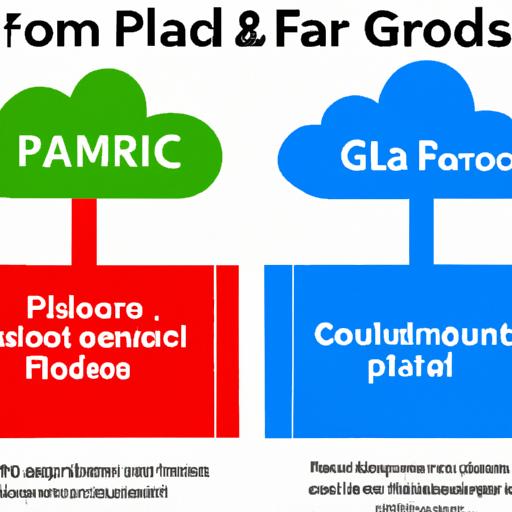Cloud
Is Google Cloud Platform Free?
[ad_1]
Introduction

Are you curious about Google Cloud Platform and wondering if it’s free to use? Well, you’ve come to the right place! In this article, I will provide you with a comprehensive answer to the burning question: “is google cloud platform free?” But before we dive into the details, let me give you a brief overview of what Google Cloud Platform is all about.
Google Cloud Platform (GCP) is a suite of cloud computing services offered by Google. It provides a wide range of tools and resources to help individuals and businesses build, deploy, and scale their applications and services in the cloud. With its robust infrastructure and cutting-edge technologies, GCP has become a go-to platform for developers, startups, and enterprises worldwide.
Now, why is it essential to understand the pricing structure of Google Cloud Platform? Well, as enticing as “free” sounds, it’s crucial to have a clear understanding of what you can expect in terms of costs. By comprehending the pricing model, you can effectively plan your usage, avoid any surprises, and make informed decisions about utilizing GCP’s services.
So, let’s delve deeper into the question: “Is Google Cloud Platform free?” Stay with me as we explore the free tier and shed light on the pricing structure of GCP.
Is Google Cloud Platform Free?

Explanation of Google Cloud Platform’s Free Tier
When it comes to Google Cloud Platform (GCP), there is indeed a free tier available. This free tier allows users to explore and experiment with various services without incurring any charges. However, it’s essential to understand the details of what is included in this free tier and the limitations that come with it.
Services Included in the Free Tier
Google Cloud Platform offers an array of services that are accessible within the free tier. These services enable you to get a taste of what GCP has to offer. Some of the key services available for free include:
- Compute Engine: With Compute Engine, you can create virtual machines and run applications in the cloud without any cost within certain usage limits.
- Cloud Storage: Google Cloud Storage provides free storage up to a specific limit, allowing you to store and retrieve your data effortlessly.
- Cloud Functions: Cloud Functions offer serverless computing capabilities, and a certain number of function invocations are available for free.
- Cloud Firestore: Firestore, Google’s NoSQL document database, provides a generous amount of storage, document reads, and writes within the free tier.
- BigQuery: BigQuery, a powerful analytics data warehouse, offers a certain amount of querying and data processing at no cost.
Usage Limits and Restrictions
While the free tier offers a fantastic opportunity to explore GCP, it’s important to be aware of the usage limits and restrictions that apply. Google sets specific quotas on the usage of each service within the free tier. These quotas define the maximum limits for resource consumption, data transfer, and other usage-related aspects. It’s crucial to keep an eye on these quotas, as exceeding them may result in additional charges.
Now that we’ve explored the services included in the free tier and the usage limits, let’s move on to understanding the overall pricing structure of Google Cloud Platform in the next section.
Understanding the Pricing Model
As you embark on your journey with Google Cloud Platform, it’s crucial to grasp the pricing model to make informed decisions about utilizing its services. Let’s take a closer look at the pricing structure of GCP and distinguish between free and paid services.
Overview of Google Cloud Platform’s Pricing Structure
Google Cloud Platform follows a pay-as-you-go pricing model, which means you only pay for the resources you use. This flexibility allows you to scale your usage up or down based on your needs, ensuring cost efficiency. GCP offers a wide range of services, including compute, storage, networking, databases, and machine learning, each with its own pricing structure.
Differentiating between Free and Paid Services
Now, let’s address the burning question: “Is Google Cloud Platform free?” The answer lies in GCP’s free tier. Google provides users with a generous free tier that allows you to explore and experiment with various services without incurring any charges. However, it’s crucial to note that the free tier has usage limits and restrictions, so it’s important to understand these limitations.
While some services are available for free within certain usage limits, others are considered paid services from the get-go. It’s vital to identify which services fall under the free tier and which are subject to charges to avoid any unexpected expenses.
In the next section, we will dive deeper into evaluating the cost of using Google Cloud Platform. By understanding the factors that contribute to costs and exploring cost optimization strategies, you’ll be equipped to make the most out of GCP while keeping your expenses in check. So, let’s move on to the next section and unravel the intricacies of cost calculation and optimization.
Evaluating the Cost of Using Google Cloud Platform
When considering using Google Cloud Platform (GCP), it’s crucial to evaluate the potential costs associated with your usage. Here are some factors to consider when calculating costs:
Factors to consider when calculating costs
1. Service usage and resource consumption
Every service you utilize on GCP incurs costs based on its usage and resource consumption. It’s essential to understand how much you will be utilizing each service and factor that into your cost calculations. For example, if you are using Compute Engine to run virtual machines, you’ll need to consider the number of instances, their sizes, and the duration of their usage.
2. Additional charges for premium features
While GCP does offer a free tier, certain advanced or premium features may have associated costs. These features often provide additional functionality and capabilities that go beyond the basic offerings. It’s important to identify the premium features you require and consider their costs when evaluating the overall expenses.
To better understand how costs can accumulate on GCP, let’s consider a couple of examples:
Examples of cost calculations
-
Let’s say you have a small e-commerce website running on GCP’s App Engine. Assuming you have moderate traffic, you might estimate the cost of your App Engine instances, storage, and network egress. By carefully analyzing your expected usage and consulting GCP’s pricing documentation, you can calculate an approximate monthly cost for your application.
-
Now, imagine you are running a data-intensive workload that requires substantial processing power and storage. You might utilize BigQuery for your data analysis and Cloud Storage for storing large volumes of data. By understanding the pricing details of these services and estimating your workload’s demands, you can calculate the expected costs and plan your budget accordingly.
By considering factors like service usage, resource consumption, and potential premium features, you can evaluate the cost implications of using Google Cloud Platform. Analyzing real-life scenarios and utilizing GCP’s pricing resources will empower you to make informed decisions about your cloud usage and budget allocation.
Cost Optimization Strategies
When it comes to using Google Cloud Platform, optimizing costs is crucial for individuals and businesses alike. Nobody wants to pay more than necessary, right? So, let’s explore some effective strategies to minimize expenses and make the most out of your GCP experience.
Tips for Minimizing Expenses on Google Cloud Platform
1. Utilizing Resource Management Tools
Managing resources efficiently is key to cost optimization on Google Cloud Platform. GCP offers a range of resource management tools that can help you analyze, monitor, and optimize your usage. For example, Cloud Monitoring provides insights into resource utilization, allowing you to identify any idle or underutilized resources. By identifying and addressing these inefficiencies, you can save costs and maximize the value of your cloud investment.
2. Implementing Auto-Scaling and Resource Allocation Strategies
Auto-scaling is a game-changer when it comes to optimizing costs on GCP. By automatically adjusting your resource allocation based on demand, you can ensure that you’re only paying for what you need at any given time. GCP offers services like Compute Engine Autoscaler, which can dynamically adjust the number of virtual machine instances based on workload fluctuations. This means you won’t be wasting resources during periods of low demand, ultimately reducing costs.
Furthermore, implementing smart resource allocation strategies can also help optimize costs. For example, by using preemptible VMs, you can take advantage of discounted pricing for short-lived, fault-tolerant workloads. Similarly, using committed use contracts can provide substantial discounts for long-term commitments to specific GCP resources.
By leveraging these cost optimization strategies, you can effectively minimize expenses on Google Cloud Platform while still enjoying its powerful features and services. So, take advantage of the resource management tools and implement auto-scaling and resource allocation strategies to optimize your costs on GCP. Your wallet will thank you!
Conclusion
In conclusion, the question “Is Google Cloud Platform free?” requires a nuanced answer. While there is a free tier available that allows you to explore and experiment with some of GCP’s services, it’s important to understand the limitations and usage restrictions associated with it. Additionally, GCP offers a range of paid services that cater to the needs of businesses and organizations with more significant requirements.
Understanding the pricing structure of Google Cloud Platform is crucial for making informed decisions about utilizing its services. By evaluating the cost factors and implementing cost optimization strategies, you can effectively manage your expenses on GCP. It’s worth noting that while GCP offers powerful tools and resources, the costs can vary depending on your usage and requirements.
Whether you’re a developer, startup, or enterprise, Google Cloud Platform provides a robust and scalable infrastructure for your cloud computing needs. As you embark on your journey with GCP, make sure to assess your usage, explore the free tier, and leverage cost optimization strategies to maximize the value you get from the platform.
So, is Google Cloud Platform free? Well, it’s free to get started, but as your needs grow, it’s important to plan and budget accordingly. Embrace the power of GCP, harness its potential, and let it propel your applications and services to new heights in the cloud.
Remember, if you have any further questions or need assistance, Google Cloud Platform’s support team is always there to guide you. Happy cloud computing!




